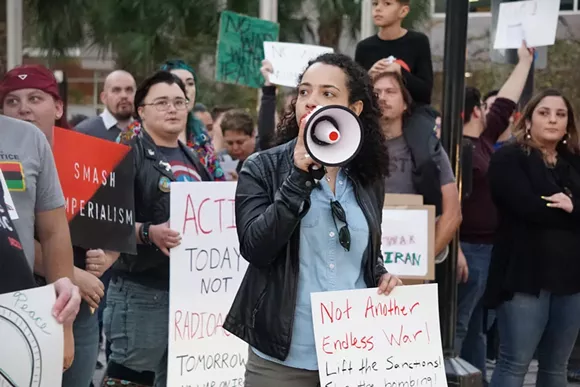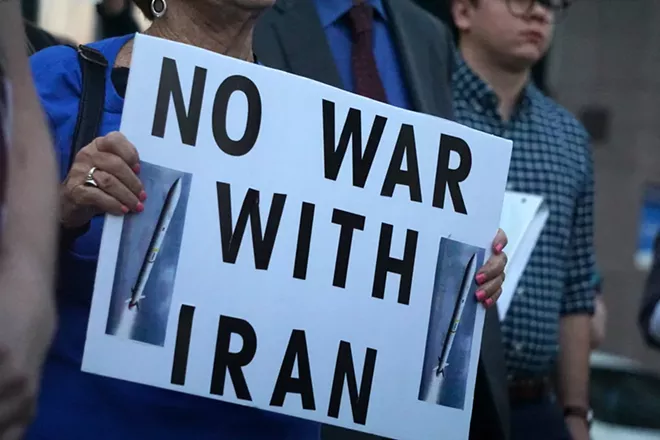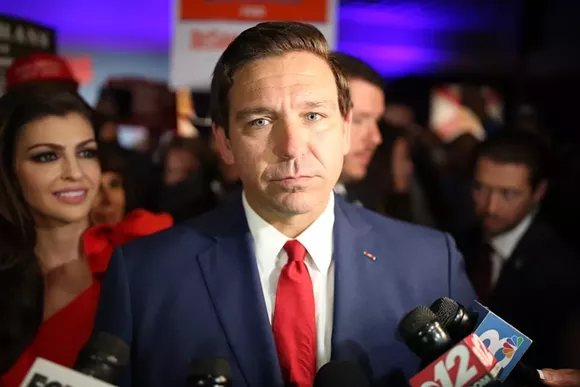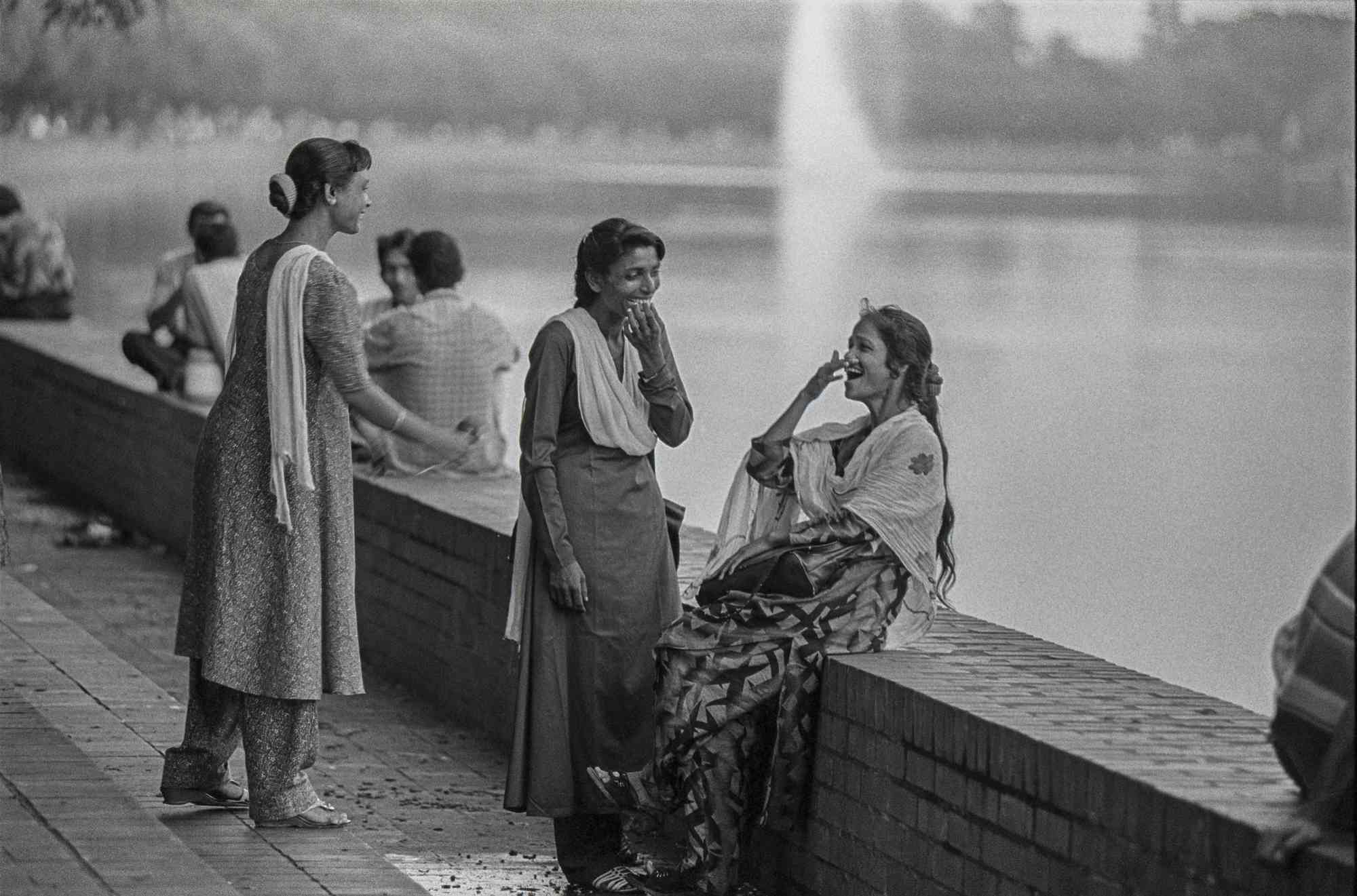Rally outside of Orlando City Hall says 'no more endless wars'
TRUMP'S NEW HOME STATE PROTESTS HIS WAR AND SANCTIONS ON IRAN
Posted By Lillian Hernández Caraballo on Fri, Jan 10, 2020

Photo by Maya JamesAmid uncertainty and anxiety over Iranian-American conflicts, public officials and locals stood in solidarity outside Orlando City Hall on Thursday evening, protesting against further violence or war.
"There is no evidence that war leads to democracy," Rep. Anna Eskamani of District 47 said. "We've seen this in many countries, like in Iraq."
The group of demonstrators cited the ineffectiveness of war and the dire importance for diplomacy as reasons to stand against further escalations.
"It serves no purpose to perpetuate constant war and violence in that region," said Grayson Lanza, a local activist who organized the event in under 24 hours. "We want diplomacy. Diplomacy works, and with Iran we have evidence of that.
Many also stated it was important to show resistance against the inconsistent and volatile leadership that has led to rising xenophobia.
"We have to be out here because we have to show that, while our president may be responsible for these actions, he does not represent all of us," said Diego Molina, an activist and member of the College Democrats at University of Central Florida. "As the general community, as people, as Americans, it's shocking and abhorrent that we have to be here doing this."
During a phone interview, attorney Katerina Kurbatova, Esq., of the law firm Smith and Kurbatova, said their Iranian clients with immigration cases have had their immigration interviews cancelled, after waiting long periods of time – some of them years – and with no end in sight, as rescheduling has been discontinued for now.
"Iranian cases have been waiting 1.5 to 2 years in an 'administrative processing' stage," Kurbatova said. "Some finally had their interviews, some were waiting to be scheduled. Now all cancelled and nothing definite for rescheduling."
Kurbatova is of Russian descent and her partner Smith is of Iranian descent. They handle a lot of immigrant cases and have first-hand seen the results that fear-mongering has had in these communities.
"It's affecting regular people in ways it shouldn't be," Kurbatova said. "They're just people who have nothing to do with politics."

Photo by Maya JamesThe speakers and attendees at the protest focused strongly around the ongoing travel ban affecting Iranians and on the recent issue at the U.S.-Canada border, where around 200 Iranian-Americans were detained for hours, harassed and questioned, before being allowed passage back to their homes in America.
"Iranian-American communities are being unfairly targeted," Lanza said. "It's terrifying the fact that this can just happen at any moment. They're just as American as anyone else; they are just as human as anyone else.
Congressman Darren Soto, representing Florida U.S. District 9, said he could not be at the event, but sent district director Sheyla Asencios, who spoke for Soto.
"I will proudly vote for peace," Asencios read aloud in behalf of Soto. "One thing is clear: war with Iran is not the answer. We don't need another endless war in the Middle East. We don't need another generation of Americans dying halfway around the world in a conflict that does not directly threaten the homeland." (Ed. – Quote corrected to "homeland" from earlier "whole land.")
Lanza said the event is but the Orlando part of a nationwide movement. He said over 300 other events like it are going on concurrently around the U.S.
"This is just the City Beautiful standing in support of peace," said Ida Eskamani, an Iranian-American grassroots organizer. "We do not want another endless war."
Rep. Anna Eskamani said she is proud American who will forever fight for peace in the U.S. and the world abroad. Eskamani is Florida's first elected Iranian-American to any public office. She and her sister Ida Eskamani have been helping their family in Iran cope with their fears and anxieties of war.
She also said that the President's rhetoric is unpredictable and that his tweet about targeting cultural sites for military attacks, a war crime, was used in Iran as propaganda to inspire fervor for anti-American sentiments.

Photo by Maya James"My family [in Iran] is super anxious,
"We have to be out here because we have to show that, while our president may be responsible for these actions, he does not represent all of us," said Diego Molina, an activist and member of the College Democrats at University of Central Florida. "As the general community, as people, as Americans, it's shocking and abhorrent that we have to be here doing this."
During a phone interview, attorney Katerina Kurbatova, Esq., of the law firm Smith and Kurbatova, said their Iranian clients with immigration cases have had their immigration interviews cancelled, after waiting long periods of time – some of them years – and with no end in sight, as rescheduling has been discontinued for now.
"Iranian cases have been waiting 1.5 to 2 years in an 'administrative processing' stage," Kurbatova said. "Some finally had their interviews, some were waiting to be scheduled. Now all cancelled and nothing definite for rescheduling."
Kurbatova is of Russian descent and her partner Smith is of Iranian descent. They handle a lot of immigrant cases and have first-hand seen the results that fear-mongering has had in these communities.
"It's affecting regular people in ways it shouldn't be," Kurbatova said. "They're just people who have nothing to do with politics."

Photo by Maya JamesThe speakers and attendees at the protest focused strongly around the ongoing travel ban affecting Iranians and on the recent issue at the U.S.-Canada border, where around 200 Iranian-Americans were detained for hours, harassed and questioned, before being allowed passage back to their homes in America.
"Iranian-American communities are being unfairly targeted," Lanza said. "It's terrifying the fact that this can just happen at any moment. They're just as American as anyone else; they are just as human as anyone else.
Congressman Darren Soto, representing Florida U.S. District 9, said he could not be at the event, but sent district director Sheyla Asencios, who spoke for Soto.
"I will proudly vote for peace," Asencios read aloud in behalf of Soto. "One thing is clear: war with Iran is not the answer. We don't need another endless war in the Middle East. We don't need another generation of Americans dying halfway around the world in a conflict that does not directly threaten the homeland." (Ed. – Quote corrected to "homeland" from earlier "whole land.")
Lanza said the event is but the Orlando part of a nationwide movement. He said over 300 other events like it are going on concurrently around the U.S.
"This is just the City Beautiful standing in support of peace," said Ida Eskamani, an Iranian-American grassroots organizer. "We do not want another endless war."
Rep. Anna Eskamani said she is proud American who will forever fight for peace in the U.S. and the world abroad. Eskamani is Florida's first elected Iranian-American to any public office. She and her sister Ida Eskamani have been helping their family in Iran cope with their fears and anxieties of war.
She also said that the President's rhetoric is unpredictable and that his tweet about targeting cultural sites for military attacks, a war crime, was used in Iran as propaganda to inspire fervor for anti-American sentiments.

Photo by Maya James"My family [in Iran] is super anxious,
super nervous," said Rep. Anna Eskamani. "Nobody wants war."
The protest had a final total of over 100 attendees and lasted about three hours. Some of the folks participating looked committed, others angry and indignant, many looked happy to have their voices heard, as cars passing by honked their horns in support.
"Together united we can accomplish anything," Lanza said. "And to all of you who came today, take pride in that because you're standing on the right side of history."
1/50





---30---
The protest had a final total of over 100 attendees and lasted about three hours. Some of the folks participating looked committed, others angry and indignant, many looked happy to have their voices heard, as cars passing by honked their horns in support.
"Together united we can accomplish anything," Lanza said. "And to all of you who came today, take pride in that because you're standing on the right side of history."
1/50

Amid uncertainty and anxiety over Iranian-American conflicts, public officials and locals stood in solidarity outside Orlando City Hall on Thursday evening, protesting against further violence or war. The group of demonstrators cited the ineffectiveness of war and the dire importance for diplomacy as reasons to stand against further escalations. Many also stated it was important to show resistance against the inconsistent and volatile leadership that has led to rising xenophobia.
The speakers and attendees at the protest focused strongly around the ongoing travel ban affecting Iranians and on the recent issue at the U.S.-Canada border, where around 200 Iranian-Americans were detained for hours, harassed and questioned, before being allowed passage back to their homes in America. The protest had a final total of over 100 attendees and lasted about three hours. Some of the folks participating looked committed, others angry and indignant, many looked happy to have their voices heard, as cars passing by honked their horns in support.




---30---

























